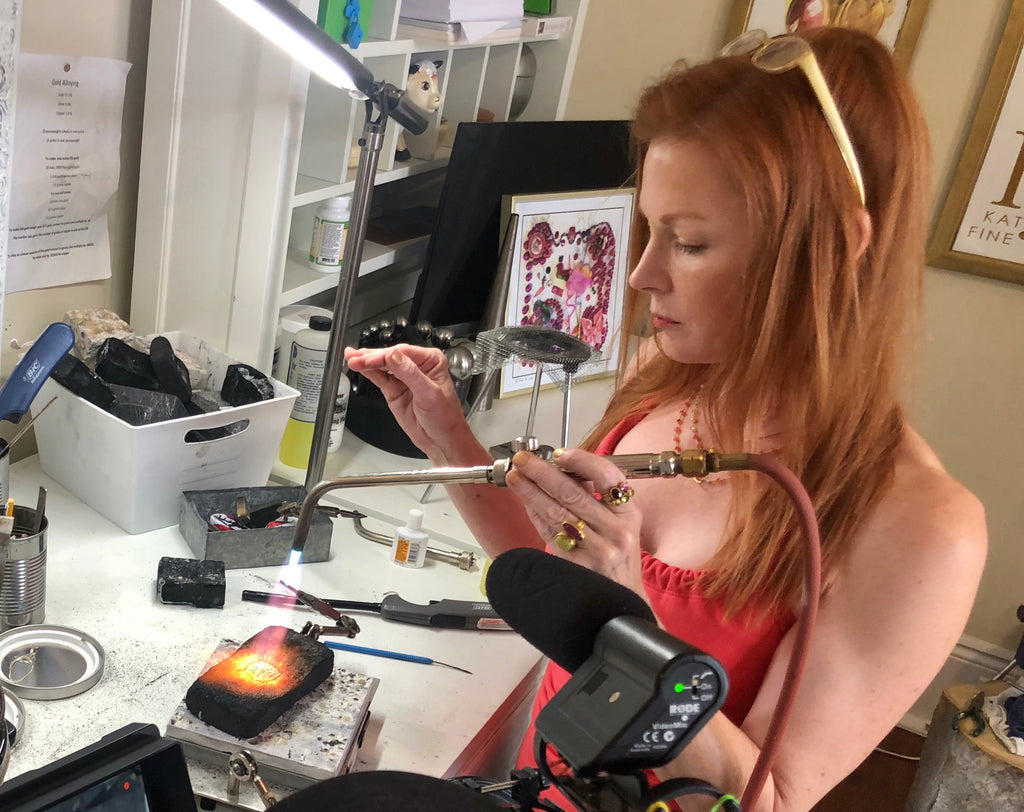What is classical goldsmithing?
In a world where most of our daily objects are mass produced, Katy Beh Jewelry is made one piece at a time by hand - mine that is. I also use the centuries old techniques of classical goldsmithing. I don't have assistants and only a few machines - a hand-held electric rotary tool and a simmering crock pot of sulfuric acid. If the power should go out during a tropical storm here in New Orleans, I'd still be happily at my bench.
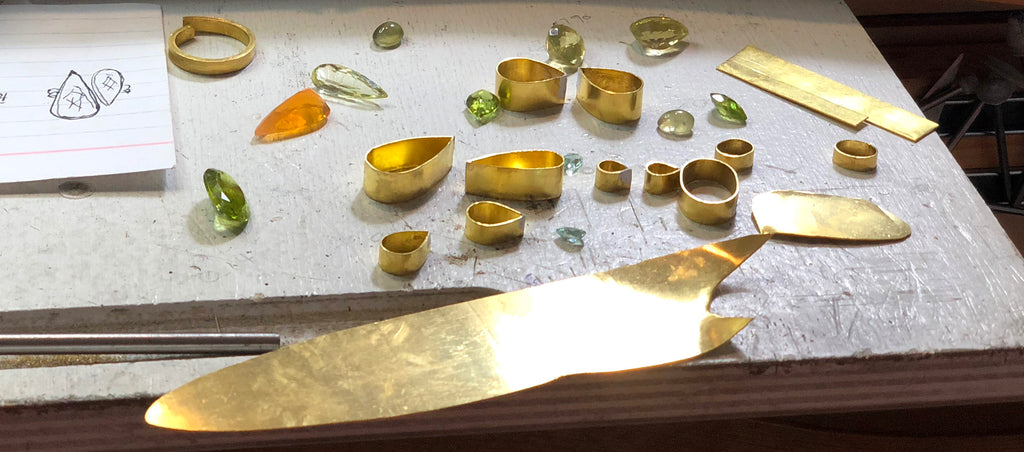
Prehistoric jewelry and gold
Jewelry is one of our earliest forms of adornments. Not humans but Neanderthals poked holes in nassarius shells making beads over 100,000 years ago.

As for gold, flakes of high purity gold have been found in Paleolithic caves from 40,000 B.C. Alluvial gold (gold found by panning in rivers) dates to the Old Stone Age along with the invention of the wheel and the domestication of animals.
The history of jewelry partnered up with the development of metallurgy in the Bronze and Iron Ages. Gold found often contained silver (electrum). Gold and silver were separated by heating the metal in a ceramic pot with common table salt. Silver was converted into silver chloride, leaving a purified gold.
It didn't take long before we were alloying gold with silver and copper to strengthen and expand it's supply. That said, gold used to make ancient jewelry (rather than coinage) was remarkably pure compared to gold we use today. In fact, ancient goldsmithing techniques such as fusing, filigree and granulation can only be accomplished using high-purity gold and silver.
Classical goldsmithing
We have classical goldsmithing thanks to 6th-5th century BC Etruscans. By 200-300 AD, the techniques had been adopted by the Roman Empire, which in turn spread the Hellenistic Greek style. But the Golden Age of Greece was itself preceded by the great civilizations of the East, specifically, 3500 BC Babylonia.
So what makes jewelry classical goldsmithing? There are several techniques that make classical goldsmithing different from other jewelry making methods:
- All of the elements are made entirely by hand - even the gold sheet and wire used is made from scratch. It is an extremely time consuming and exacting hands-on craft.
- The almost exclusive use of 22k yellow gold or fine silver
- Techniques such as fusing, filigree and granulation, chasing and repousse - these can only be achieved in high purity metals.
Ancient goldsmiths
Classically made jewelry is usually gold and built from numerous hand fabricated components. Think architecture or house building rather than sculpture. Rather than making multiples by casting or machines to create their designs, they relied on time and skill to produce their wares.
Ancient goldsmiths worked in small home based shops, passing down the trade to children or apprentice. They worked with a repertoire of miniature tools. Attached to their narrow workbench would be a fabric drape to catch filings and nearby a foot bellow oil lamp torch. Not too different from today, huh?
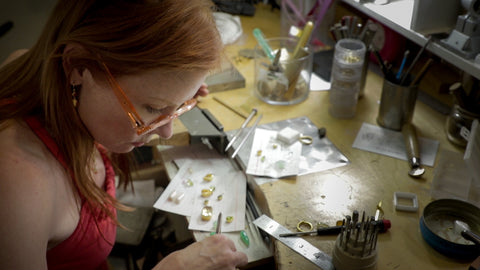
- Gold jewelry was usually formed from hammered out sheet.
- The sheet was cut into smaller pieces with a small chisel.
- The sheet was shaped with hard tools ranging from wooden sticks to bronze punches and dies.
- Wire was formed by rolling thin strips of gold between two hard blocks.
-
Three-dimensional forms could be made in several ways:
- forged (using the plasticity of the metal; shaped with a hammer) from an ingot.
- constructed by soldering together the edges of separate sheets of gold
- repousse(d) (sheet shaped by pushing with tools from the back side) gold sheet soldered together.
In classical goldsmithing, the individual parts of each jewelry component were each separately constructed and then the components were soldered or fastened with cold connections like rivets, tabs or links.
Once assembled and soldered, the piece would be finished with a fine abrasive or burnished (rubbed with a hard tool). For pieces featuring fine details like granulation and filigree, a slightly corrosive solution like alum, salt and urine were used to clean and brighten the gold. Ultimately, the gold took on its renowned rich patina from being worn.
Classical goldsmithing techniques
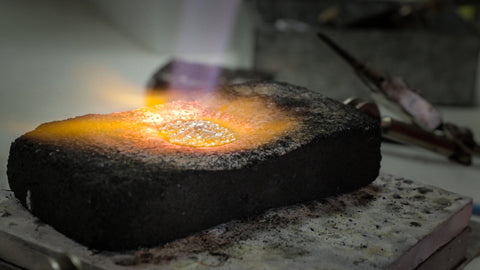
Classical goldsmithing techniques can only be achieved with the purest of metals. That is why today's classical goldsmiths alloy the gold they use. Controlled environments and exacting recipes make for a gold alloy suitable for high temperature techniques.
Filigree - twisted, curled or braided threads of gold fused together in a pattern using the flame from a blowpipe.
Granulation - tiny, spherical gold beads fused into a patterned onto a flat gold surface
Bezel - a metal rim or collar that emcompasses and holds a gemstone into place when the top edge of the strip is evenly pushed over a thin edge of the stone.
The techniques of repoussé and chasing use the plasticity of metal, forming a little bit at a time. There is no loss of metal in the process as it is stretched in place and the surface remains continuous. It a very slow process but it ultimately creates a form of one continuous piece of metal. The artist's' hand - tool marks - are usually visible in the finished piece.
Chasing - refines the repousse design on the front by sinking the metal. The term chasing is derived from the noun "chase", which refers to a groove, furrow, channel, or indentation.
Casting (liquid metal poured into a mold) was rarely used. It was impossible to design for a predetermined weight of gold, and in any case, high-purity gold tends not to produce sharp, clean castings. Superb detail is the hallmark of ancient gold jewelry.
Gold
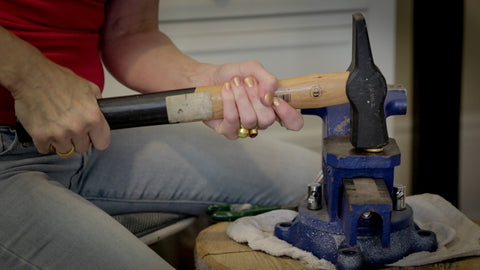
The role in which the physical properties of gold impact making ancient jewelry cannot be overemphasized. Think chicken and the egg. You can't have one without the other.
Raw (dead soft), high-karat gold is malleable. The hammering and forging used while shaping the gold compacts the molecules and makes it dense and strong. However, worked past it's malleability, the gold will flake, crack and eventually break.
When making a piece of jewelry, separate components are frequently wrought to the brink of this "work-hardened" state and are then "annealed," returning the metal to its original plasticity, yet maintaining its pre-annealed form.
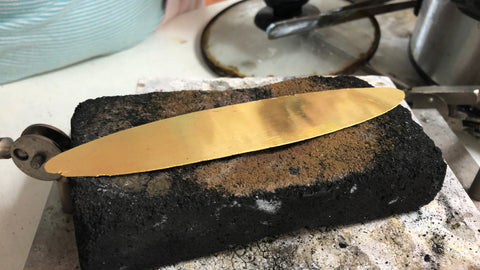
Finding the sweet spot of flexibility and strength is essential to creating a structurally sound form from supple gold. All techniques must be mastered and successful as each step is the foundation of the next. There's no room for fudging or the piece falls apart.
Pure gold (100% AU) is referred to as 24 karat gold. The term karat is an ancient term for purity and weight based on the Carob bean found in the Middle East.
Fun fact, Greece is not naturally rich in gold. The amount of gold jewelry produced in Greece at the time reflects foreign trade and influence. Funny isn't it, Alexander the Great's conquests after 331 BC passed through all the main gold-supplying regions of the former Persian Empire.
When you hear the terms 22K or 18K gold, its referring to the amount of pure gold in the piece of jewellery. For example; a 22 karat gold ring has:
- 22/24 parts gold.
- 2/24 parts of silver and copper.
- 22k gold is 91.67% pure gold.
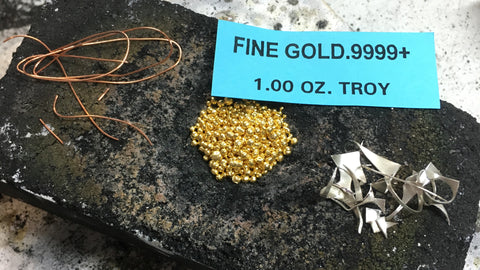
Read here for more about 22k gold.

